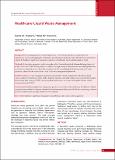Please use this identifier to cite or link to this item:
https://hdl.handle.net/20.500.14356/2007Full metadata record
| DC Field | Value | Language |
|---|---|---|
| dc.contributor.author | Pathak, R P | - |
| dc.contributor.author | Shrestha, S C | - |
| dc.contributor.author | Sharma, D R | - |
| dc.contributor.author | Pradhan, B | - |
| dc.date.accessioned | 2023-06-05T09:03:55Z | - |
| dc.date.available | 2023-06-05T09:03:55Z | - |
| dc.date.issued | 2010 | - |
| dc.identifier.citation | PathakR. P., ShresthaS. C., SharmaD. R., & PradhanB. (2010). Healthcare Liquid Waste Management. Journal of Nepal Health Research Council. https://doi.org/10.33314/jnhrc.v0i0.218 | en_US |
| dc.identifier.issn | Print ISSN: 1727-5482; Online ISSN: 1999-6217 | - |
| dc.identifier.uri | http://103.69.126.140:8080/handle/20.500.14356/2007 | - |
| dc.description | Original Article | en_US |
| dc.description.abstract | Abstract Background: The management of healthcare liquid waste is an overlooked problem in Nepal with stern repercussions in terms of damaging the environment and affecting the health of people. This study was carried out to explore the healthcare liquid waste management practices in Kathmandu based central hospitals of Nepal.           Methods: A descriptive prospective study was conducted in 10 central hospitals of Kathmandu during the period of May to December 2008. Primary data were collected through interview, observation and microbiology laboratory works and secondary data were collected by records review. For microbiological laboratory works, waste water specimens cultured for the enumeration of total viable counts using standard protocols.  Results: Evidence of waste management guidelines and committees for the management of healthcare liquid wastes could not be found in any of the studied hospitals. Similarly, total viable counts heavily exceeded the standard heterotrophic plate count (p=0.000) with no significant difference in such counts in hospitals with and without treatment plants (p=0.232). Conclusions: Healthcare liquid waste management practice was not found to be satisfactory. Installation of effluent treatment plants and the development of standards for environmental indicators with effective monitoring, evaluation and strict control via relevant legal frameworks were realized.               Key words: healthcare, liquid waste management, microbiology, platen count, waste management | en_US |
| dc.language.iso | en | en_US |
| dc.publisher | Nepal Health Research Council | en_US |
| dc.relation.ispartofseries | October;218 | - |
| dc.subject | Healthcare | en_US |
| dc.subject | Liquid waste management | en_US |
| dc.subject | Microbiology | en_US |
| dc.subject | Platen count | en_US |
| dc.subject | Waste management | en_US |
| dc.title | Healthcare Liquid Waste Management | en_US |
| dc.type | Journal Article | en_US |
| local.journal.category | Original Article | - |
| Appears in Collections: | Vol 8 No 1 Issue 16 April 2010 | |
Files in This Item:
| File | Description | Size | Format | |
|---|---|---|---|---|
| 218-Article Text-216-1-10-20130822.pdf | Fulltext Download | 183.39 kB | Adobe PDF |  View/Open |
Items in DSpace are protected by copyright, with all rights reserved, unless otherwise indicated.
